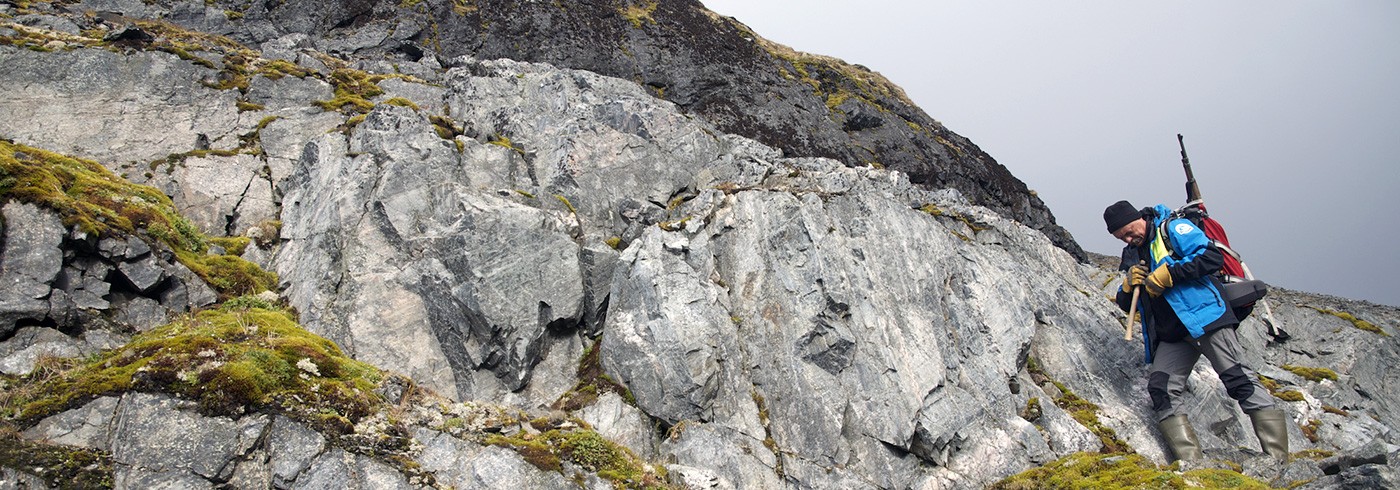We escaped from Båthamna with the evening high tide on the 23rd. Strong winds around Sørkapp and from the largest glacier in the area, Olsokbreen, made the first 90 minutes of the trip rather uncomfortable. Then the sea was calm but full of ice. In the middle of Hornsund the waves were high and breaking – no immediate danger to the Zodiac but a pain because of the high luggage which was blocking the view for a sitting driver for timely reaction. But Majek has the right proportions to drive a longer time while standing in the Zodiac, so finally we arrived in Hyttevika, about 15 km northwest of the Polish station. Here, a small former trapper’s hut is available for use for Polish scientists.
Yesterday we walked to the station to pick up some of our belongings which we left behind for the trip to Sørkapp, and some fresh food. A nice trip, but against the wind – and we took already the first samples from this region. Promising was also that the wind would ”carry” us back with our heavy backpacks.
The station was full of people because of a visit by the supply and research vessel ”Horyzont II”. Jarek left us with the ship after an emergency call from his lab (National Microprobe Facility in Uppsala), that they can’t get the machine working without him – apparently already a couple of weeks downtime. A good coincidence that all important work is done, the weather drove us back from Sørkapp and the ship had and empty place to Longyearbyen!
The remains of our group went back to Hyttevika around midnight. The wind was playing games on the sea when we approached the hut, little ”tornados” dragging up water, wind gusts alternating from the north and south around the mountain, accompanied by falling winds from its top. Not a nice walk in other words.
When we arrived at Hyttevika we were scared up by Majek’s scream ”Where the f… is the Zodiac!?!”. The beach was empty – no Zodiac, despite it being properly anchored in a, for this purpose, deeply buried driftwood log. When we came a little bit closer we saw it lying upside down further up. Apparently the wind took it to the air like a kite, turned it over and banged it upside down on the beach at full length of the anchor rope. There we found the boat’s ”contents” in a nice pile – service box, paddle and engine hood (which always was loose). Then the boat took to the air again, now in opposite direction banging the unprotected engine to the ground, breaking a few parts and getting in sand everywhere where it nicely sticks on the greasy surfaces.
The boat and engine alone have a weight of about 220 kg. We secured the boat as good as possible with driftwood logs and went to bed. More heavy wind during the night, the hut rattled like an old train, or maybe a better comparison is an old airplane that just didn’t get off the ground… We will see what we can do with the engine. Cleaning and repairing, the latter with help from the Polish station. At least it is not critical since we do not rely on boat transport other than back to the station when we leave in 8–9 days – although we will miss some localities.
I just thought today would be boring when we saw that M/S Stockholm arrived in the bay. Nothing happened for some time, but at about three o’clock in the afternoon a Zodiac came to the shore – a group of mainly biologists on a trip around Svalbard to judge the impact of tourism on nature – also refugees from the hard weather at the east coast. We had a nice talk about what they and we are doing, explaining our expedition and geological work in the Arctic in general.
A mechanic had a look at our engine, but it doesn’t look to good – spare parts are needed. Then the group went of for a walk towards Werenskiöldbreen while Jan-Morten, a journalist accompanying the group, was staying with us to get ”a story”. Great! Publicity is what Earth Sciences needs! After some hours the group returned and both Jan-Morten and we were very satisfied. We even more when they brought us a box of beer! Thank you very much! 🙂
Now the wind is up again, and the gusts are so strong that rock piles, which have been in front of the hut for decades, are collapsing.
Henning Lorenz, Uppsala University












